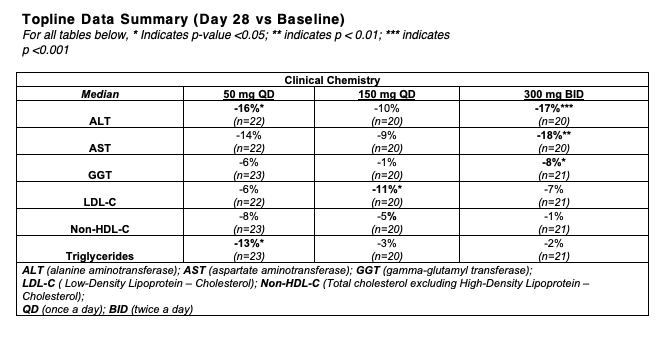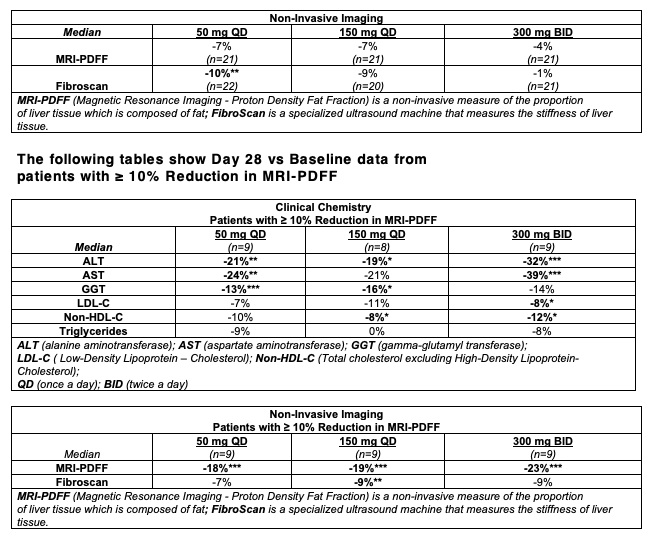| |
DURECT Corporation Announces Positive Topline
Data from Phase 1b Study of DUR-928 in NASH
|
| |
| |
-- Improvements in both serum liver enzymes and liver imaging
-- Improvement in serum lipid profile
-- DUR-928 was well tolerated with no significant adverse events
-- Promising data support further development of DUR-928 in NASH
The study was a randomized, open label, multi center US study to evaluate safety, pharmacokinetics and signals of biological activity of DUR-928 in NASH patients with stage 1-3 fibrosis. A total of 65 patients completed the study. DUR-928 was orally administered daily at 50 mg (n=23), 150 mg (n=21), or 600 mg (300 mg BID (n=21)). Patients in this trial were dosed daily for 4 weeks and followed up for an additional 4 weeks.
DUR‑928 is a new chemical entity and the first endogenous epigenetic regulator clinically tested for difficult-to-treat liver diseases. It is the lead candidate in DURECT's Epigenetic Regulator Program and is currently being tested in Phase 1 and Phase 2 development. An endogenous, orally bioavailable, small molecule, DUR-928 has been shown in preclinical studies to play an important regulatory role in lipid homeostasis, inflammation, and cell survival. Human applications may include acute organ injury such as alcoholic hepatitis (AH), acute liver or kidney injury in COVID-19 patients, and chronic metabolic diseases such as nonalcoholic steatohepatitis (NASH), nonalcoholic fatty liver disease (NAFLD), and other liver diseases.
CUPERTINO, Calif., May 26, 2020 /PRNewswire/ -- DURECT Corporation (Nasdaq: DRRX) today announced positive topline results from its Phase 1b clinical study of orally administered DUR-928 in nonalcoholic steatohepatitis (NASH) patients.
A total of 65 patients completed the study, in which DUR-928 was orally administered daily for 4 weeks at 50 mg (n=23), 150 mg (n=21), or 600 mg (300 mg BID (n=21)). Both the 50 mg and 600 mg dose groups showed a statistically significant median reduction at day 28 from baseline of serum alanine aminotransferase (ALT) levels at -16% and -17%, respectively. The 600 mg dose group also showed statistically significant median reductions at day 28 from baseline of serum aspartate aminotransferase (AST) (-18%) and gamma-glutamyl transferase (GGT) (-8%), and the 50 mg dose group had a statistically significant reduction at day 28 from baseline in liver stiffness as measured by Fibroscan (-10%).
Patients in the 50 mg or 150 mg dose groups also had statistically significant median reduction at day 28 from baseline of serum triglycerides (-13% in the 50 mg group) or LDL-C (-11% in the 150mg group). Patients with elevated baseline triglycerides (≥200 mg/dL; n=16) across all dose groups had a median reduction at day 28 from baseline of -24% (p <0.01).
At day 28, 43% of patients in all three dose groups showed ≥ 10% liver fat reduction from baseline as measured by magnetic resonance imaging - proton density fat fraction (MRI-PDFF). In this subgroup, there was a significant reduction from baseline in median liver fat content (-18%, -19%, and -23%, in the 50 mg, 150 mg and 600 mg groups respectively). The reduction of liver fat content was accompanied by a significant median reduction from baseline of serum ALT (-21%, -19%, and -32%, in the 50 mg, 150 mg and 600 mg groups respectively).
DUR-928 was well tolerated at all three doses evaluated. There were no serious adverse events reported during the study.
Pharmacokinetic (PK) parameters after repeat dosing were comparable to those after a single dose (from a prior study), indicating no accumulation after repeat dosing. Drug exposure was dose dependent.
Results, including biomarker data, are still being analyzed. DURECT plans to present additional results and data analyses at a future scientific meeting.
"The results from this trial are encouraging given the short treatment course of 4 weeks to establish proof of concept," stated Dr. Eric Lawitz, Texas Liver Institute, University of Texas Health San Antonio and principal investigator of the study. "I look forward to further development of what appears to be a well-tolerated drug with the potential to treat NASH patients through modulation of multiple biologic pathways."
"It is impressive to see these improvements after such a short treatment period," stated James E. Brown, D.V.M., President and CEO of DURECT. "Multiple important liver enzymes, plasma lipids and imaging results moving in the same direction is a very promising indication of DUR-928's potential in NASH."


About the Study
The study was a randomized, open label, multi center US study to evaluate safety, pharmacokinetics and signals of biological activity of DUR-928 in NASH patients with stage 1-3 fibrosis. A total of 65 patients completed the study. DUR-928 was orally administered daily at 50 mg (n=23), 150 mg (n=21), or 600 mg (300 mg BID (n=21)). Patients in this trial were dosed daily for 4 weeks and followed up for an additional 4 weeks.
About DUR-928
DUR‑928 is a new chemical entity and the first endogenous epigenetic regulator clinically tested for difficult-to-treat liver diseases. It is the lead candidate in DURECT's Epigenetic Regulator Program and is currently being tested in Phase 1 and Phase 2 development. An endogenous, orally bioavailable, small molecule, DUR-928 has been shown in preclinical studies to play an important regulatory role in lipid homeostasis, inflammation, and cell survival. Human applications may include acute organ injury such as alcoholic hepatitis (AH), acute liver or kidney injury in COVID-19 patients, and chronic metabolic diseases such as nonalcoholic steatohepatitis (NASH), nonalcoholic fatty liver disease (NAFLD), and other liver diseases.
About DURECT Corporation
DURECT is a biopharmaceutical company committed to transforming the treatment of acute organ injury and chronic liver diseases by advancing novel and potentially lifesaving therapies based on its endogenous epigenetic regulator program. DURECT's lead candidate, DUR-928, has demonstrated the ability to regulate the expression of genes involved in lipid metabolism, inflammatory responses and cell survival. This drug candidate is currently in Phase 2 development for the treatment of alcoholic hepatitis (AH), and Phase 1 development for the treatment of nonalcoholic steatohepatitis (NASH). We are also working with the FDA on the design of a proof-of-concept Phase 2 trial of DUR-928 in COVID-19 patients with acute liver or kidney injury. DURECT's proprietary drug delivery technologies are designed to enable new indications and enhanced attributes for small-molecule and biologic drugs. A key product candidate in this category is POSIMIR® (bupivacaine extended-release solution), an investigational locally-acting, non-opioid analgesic intended to provide up to three days of continuous pain relief after surgery. DURECT has also entered into an agreement with Gilead Sciences to develop and commercialize a long-acting injectable HIV investigational product using DURECT's SABER® technology. For more information about DURECT, please visit www.durect.com.
DURECT Forward-Looking Statement
The statements in this press release regarding the potential for DUR-928 to treat NASH patients and other plans for clinical development of DUR-928, including plans to conduct a Phase 2 clinical trial of DUR-928 in COVID-19 patients, and the potential benefits and uses of our drug candidates, including the potential use of DUR-928 to treat acute organ injuries such as AH and COVID-19 patients with acute liver or kidney injury, are forward-looking statements involving risks and uncertainties that can cause actual results to differ materially from those in such forward-looking statements. Potential risks and uncertainties include, but are not limited to, the risks that future clinical trials of DUR-928 do not confirm the results of trials conducted on small numbers of patients, are not started when anticipated, take longer to conduct than anticipated, do not generate similar positive results as generated in earlier clinical or pre-clinical trials, or do not demonstrate the safety or efficacy of DUR-928 in a statistically significant manner, the risk that the remaining data from the Phase 1b NASH trial reported in this press release is not consistent with the topline data reported here, the risk of disruptions to our business operations resulting from the COVID-19 pandemic, the risk that additional time and resources may be required for development, testing and regulatory approval of DUR-928, potential adverse effects arising from the testing or use of our drug candidates, our potential failure to maintain our collaborative agreements with third parties such as Gilead or consummate new collaborations and risks related to our ability to obtain capital to fund operations and expenses. Further information regarding these and other risks is included in DURECT's Form 10-Q filed on May 11, 2020 under the heading "Risk Factors."
NOTE: POSIMIR® and SABER® are trademarks of DURECT Corporation. Other referenced trademarks belong to their respective owners. DUR-928 and POSIMIR are investigational drug candidates under development and have not been approved for commercialization by the U.S. Food and Drug Administration or other health authorities for any indication.
| |
| |
| |
|
|
|